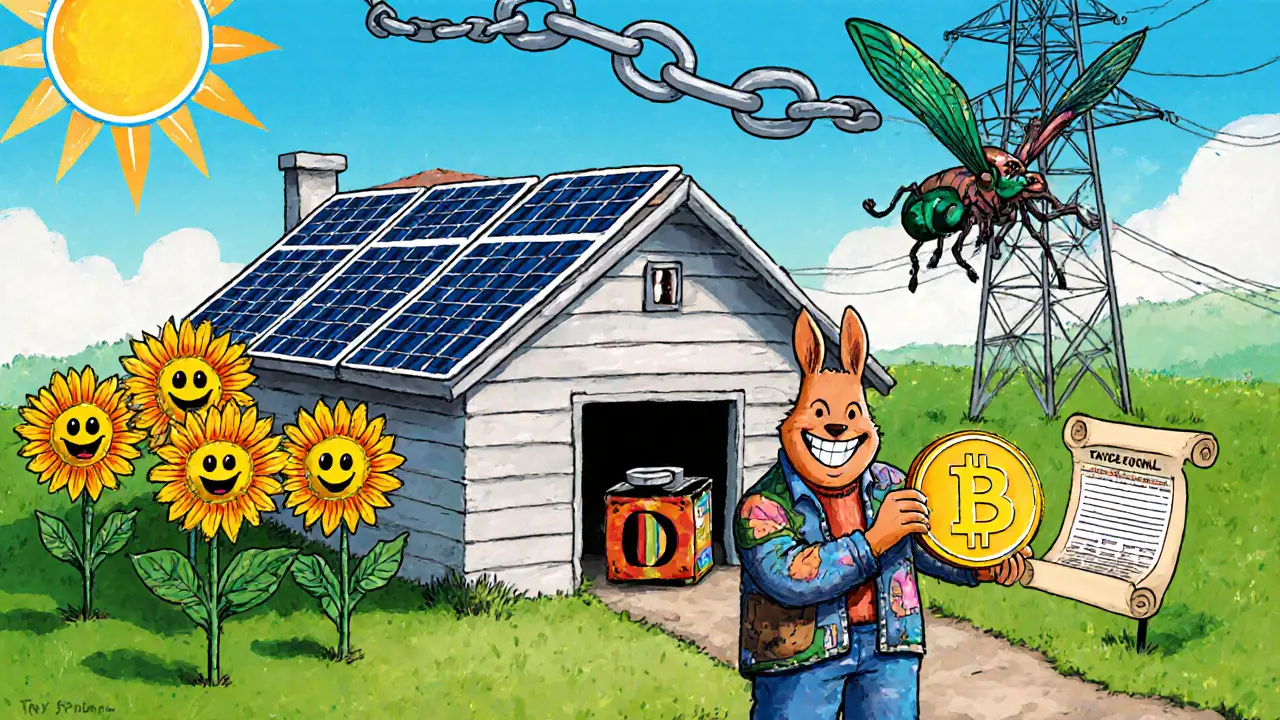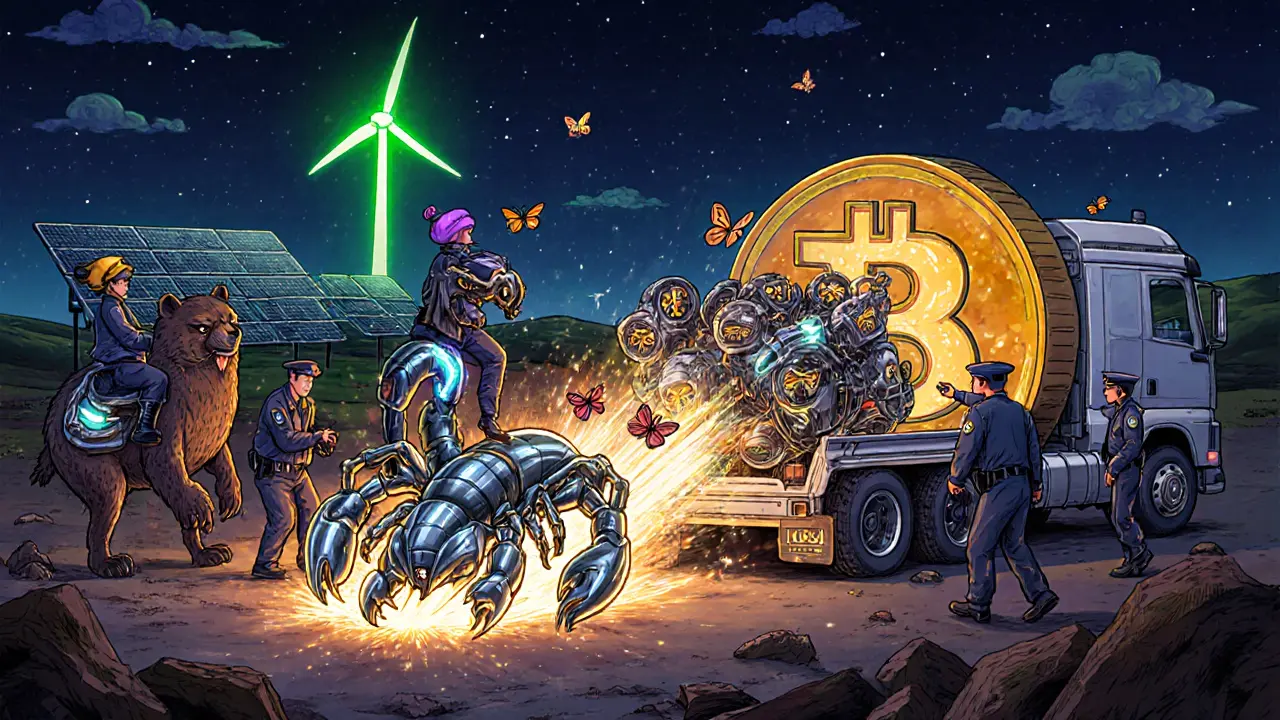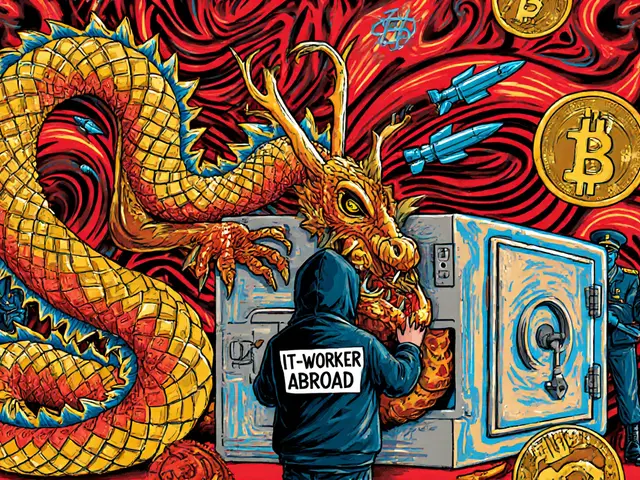Kosovo Crypto Mining Energy Calculator
Energy Calculator
Calculate how much electricity your crypto mining operation consumes and what it means for Kosovo's grid.
Kosovo shut down crypto mining to keep the lights on
In January 2022, Kosovo turned off the power to thousands of cryptocurrency mining rigs - not because they were illegal, but because the country was running out of electricity. Homes were going without heat in winter. Hospitals were on backup generators. And miners, using subsidized power to run rows of buzzing machines, were siphoning off enough electricity to power entire towns. The government didn’t have a choice.
By the end of 2021, one of Kosovo’s two major coal-fired power plants had shut down. Imports couldn’t keep up. The national grid was buckling. The acting Economy Minister, Artane Rizvanolli, declared a 60-day state of emergency. Within days, police raided mining farms across the country, seizing over 5,000 ASIC miners - machines worth $20,000 to $30,000 each. In northern Kosovo, where unemployment was high and wages low, some miners were making $2,270 a month - five times the average income. That kind of profit, powered by free electricity, became a national crisis.
Why crypto mining was eating Kosovo’s power grid
Cryptocurrency mining doesn’t just use electricity - it guzzles it. Bitcoin miners solve complex math problems to validate transactions, and the only way to win is to run more machines, faster. Each machine draws power like a small heater. A single large mining farm in Kosovo could consume as much electricity as a small city. And in a country where nearly 90% of electricity came from aging coal plants, this wasn’t sustainable.
Before the ban, miners didn’t pay for their power. Many connected directly to low-voltage lines or tapped into unofficial circuits. In some villages, entire neighborhoods were wired to mining rigs. Local authorities couldn’t track who was using what. The result? Blackouts that lasted 12 hours a day. Schools closed. Factories shut down. People started hoarding candles and batteries.
University of Cambridge data showed that globally, only 39% of Bitcoin mining used renewable energy. In Kosovo, where coal dominated, the carbon footprint of each mined Bitcoin was among the highest in Europe. The government didn’t just want to save money - it wanted to save lives.
The ban wasn’t permanent - it was just the beginning
By mid-2023, the emergency was over. Power plants were repaired. Imports stabilized. But the government didn’t lift the ban. Instead, it rewrote the rules.
Today, crypto mining in Kosovo is legal - but only if you don’t use the national grid. Miners can operate if they power their rigs with solar panels, wind turbines, or private generators. They must register their equipment with the Ministry of Economy and pay taxes on profits. The goal isn’t to kill crypto - it’s to make sure it doesn’t steal from the public.
Former parliamentary working group chair Mimoza Kusari-Lila put it simply: "We’re not against innovation. We’re against theft." The state no longer wants to be the energy provider for private profit. If you want to mine, you pay for your own power - and you pay taxes on what you earn.

Why the law is still stuck
Even though the ban was lifted in principle, the formal law hasn’t passed yet. As of 2025, Kosovo’s draft cryptocurrency legislation is 90% complete. But it’s been delayed - not by local politics, but by Brussels.
The European Commission sent two financial compliance officers to review the draft. Their main concern? Money laundering. Kosovo has a history of informal economies and weak oversight. The EU wanted guarantees that mining profits couldn’t be used to hide illicit cash. The draft now includes mandatory KYC checks for all mining operators, transaction reporting, and audits of mining farm ownership.
Local experts say the delays are frustrating. "We’ve been waiting for two years for a law that already exists in Germany and Lithuania," said Jeta Statovci, vice-president of Kosovo’s Industry Committee. "We’re not asking for special treatment. We just want clear rules so honest miners can work without fear."
What happened to the miners?
Some gave up. Others moved. A few adapted.
In Pristina, dozens of former miners now run small solar-powered mining setups on rooftops. One operator, Bekim, turned his garage into a mini-farm powered by six solar panels and a battery bank. He’s not making $2,000 a month anymore - but he’s making $400, legally, and he pays his taxes. "I used to think the grid was free," he said. "Now I know it belongs to everyone."
Others fled to neighboring countries. North Macedonia and Albania, with cheaper grid power and looser rules, saw a spike in Kosovo miners setting up shop. Some even brought their machines back to Kosovo illegally - only to be caught again in 2024 during a new round of inspections. The government says it’s caught over 200 illegal rigs since the ban was modified.

How Kosovo’s approach compares to the world
Kosovo isn’t alone. In 2021, China banned all crypto mining - shutting down 75% of the world’s Bitcoin operations overnight. Iran, Egypt, and Algeria followed with partial or full bans. But Kosovo’s story is different. It didn’t ban mining because it feared crypto. It banned it because it had no power left.
Now, it’s trying something new: conditional permission. Only renewable-powered mining is allowed. That makes Kosovo one of the few countries to tie crypto regulation directly to climate and energy policy. It’s not about stopping innovation - it’s about making sure innovation doesn’t break the system.
Compare that to the U.S., where miners flock to states like Texas because of cheap, often fossil-fuel-powered electricity. Or Kazakhstan, where miners rushed in after China’s ban, overloading the grid and forcing the government to cut power to homes during winter. Kosovo chose a middle path: no free rides, no grid theft, no excuses.
What does this mean for the future of crypto?
Kosovo’s model might be the future for other countries facing energy shortages. If you live in a place where power is scarce - say, Lebanon, Sri Lanka, or parts of Africa - you won’t be able to let crypto miners drain your grid. The smartest governments won’t ban crypto. They’ll make it pay its fair share.
That means: no subsidies. No hidden connections. No anonymous operations. If you mine, you install your own solar panels. You report your income. You follow the rules. And if you break them? Your machines get confiscated. Again.
Kosovo didn’t win the crypto war. It didn’t even try to. It just made sure the lights stayed on for its people. And in the end, that’s more important than any blockchain ledger.
Can you still mine crypto in Kosovo today?
Yes - but only if you’re not using the national grid. You must own your power source: solar, wind, or a private generator. You must register your equipment. You must pay taxes. And you must be ready for inspections. The government doesn’t care if you mine Bitcoin, Ethereum, or Dogecoin. It only cares that you don’t steal electricity from your neighbors.
Why did Kosovo ban crypto mining in the first place?
Kosovo banned crypto mining in January 2022 because the country was facing a severe energy crisis. One of its two main coal power plants had shut down, and the national grid couldn’t keep up with demand. Miners, using free or heavily subsidized electricity, were consuming massive amounts of power - enough to cause daily blackouts for homes, hospitals, and schools. The government acted to prevent further strain on the grid and protect public access to electricity.
Is crypto mining completely illegal in Kosovo now?
No. As of 2025, crypto mining is legal in Kosovo - but only if you use your own power source, like solar panels, wind turbines, or private generators. Mining using electricity from the national grid is still strictly banned. Miners must register their equipment and pay taxes on earnings.
How much electricity does crypto mining use in Kosovo?
Before the ban, mining operations in Kosovo were estimated to consume up to 15% of the country’s total electricity output - enough to power over 100,000 homes. A single large mining farm could use as much power as a small town. After the ban, usage dropped by over 90%, helping stabilize the grid and reduce blackouts.
What happened to the miners after the ban?
Many miners lost their equipment when police seized over 5,000 rigs in early 2022. Some stopped mining entirely. Others moved to neighboring countries like North Macedonia. A smaller group adapted by switching to solar-powered setups in their homes or garages, operating legally under the new rules. A few tried to hide their rigs again - but were caught in follow-up raids in 2023 and 2024.
Why hasn’t Kosovo passed a full crypto law yet?
The draft law is nearly finished, but it’s been delayed because the European Commission requested changes to strengthen anti-money laundering rules. Kosovo must prove that mining profits can’t be used to hide illegal money. The government is working with EU advisers to add KYC checks, transaction reporting, and ownership verification to the law before it’s finalized.
Is Kosovo’s approach a model for other countries?
Yes. Kosovo’s model - banning grid-powered mining but allowing renewable-powered mining under regulation - is being watched by other countries facing energy shortages. Unlike China’s total ban or the U.S.’s laissez-faire approach, Kosovo tied crypto rules directly to energy security. It’s a practical solution: let innovation happen, but not at the cost of public power.











13 Comments
Kosovo banned mining because people were stealing electricity? LOL. In Texas we pay $0.03/kWh and miners are heroes. Who cares if your grid's falling apart? That's your problem not mine.
I just think about how many people in Kosovo had to choose between heating their homes and paying for their kid's medicine while miners were running rigs in garages... I mean it's not like the miners were starving or anything. They were making five times the average wage. That's not entrepreneurship that's exploitation dressed up as innovation. And now they're all off to North Macedonia? Classic. The real innovation is how fast people move when the gravy train stops.
Honestly this is one of the most reasonable approaches I've seen. If you want to mine, build your own power. No free rides. No blaming the government. No drama. Just take responsibility. It's not anti-crypto, it's pro-accountability. And honestly? More places should do this. We're all sharing the same planet, you know?
you know what is real energy crisis? when you are poor and someone else is rich from your pain... crypto is not evil but system is evil... why we let rich people take our air our water our light? why we let them mine while children shiver? capitalism is a vampire and crypto is its fang... we need revolution not regulation...
Hey everyone, just wanted to add a real-world note: solar-powered mining in Kosovo isn't just legal - it's actually becoming a small industry. Some guys are selling DIY solar-mining kits now. One guy even started a YouTube channel showing how to hook up 12 panels to a few ASICs. It’s not glamorous, but it’s sustainable. And guess what? The tax revenue is helping fund rural electrification projects. So it’s not just about stopping theft - it’s about building something better.
There's something profoundly tragic about this whole situation. We live in a world where the most advanced technology on earth - decentralized, immutable, cryptographic ledgers - is being used to siphon electricity from children's bedrooms, from hospital ventilators, from the last warm light in a widow’s kitchen. And we call it innovation? No. This isn't innovation. This is the sound of civilization rotting from the inside, where profit has become a religion and human need is just a footnote in the whitepaper. Kosovo didn't ban crypto. They refused to let their people become collateral damage in a global game of digital roulette.
Oh wow. A country that actually enforces rules? Shocking. Next they’ll require miners to wear helmets and sign liability waivers. The EU’s KYC requirements are just bureaucratic theater. Everyone knows the real reason they’re delaying? They’re scared Kosovo might actually succeed. A working model? That’s scarier than any crypto crash.
Kosovo’s approach is a textbook case of institutional pragmatism. Unlike the ideological rigidity of China’s outright ban or the laissez-faire chaos of Texas, Kosovo implemented a cost-internalization mechanism that aligns private incentive with public welfare. The regulatory architecture is elegant: non-grid power + registration + taxation. It transforms an externality into a market transaction. This is not anti-innovation. It is innovation constrained by ecological and social responsibility - a necessary evolution in the post-climate-collapse era.
I love this so much 😭✨ Imagine if every country said: "If you want to use our grid, you pay your share." No more free riders. No more blackouts. Just clean energy + clean rules. Kosovo’s not stopping crypto - they’re just making it grown-up. 💪☀️
wait so you can mine if you have solar? that's kinda cool... but like... how many people actually have the cash for that? i mean sure it's legal but isn't this just a fancy way of saying "only rich people can mine now"? 😅
Africa is watching. Nigeria is burning diesel generators while crypto boys in Lagos run rigs on stolen grid power. Kosovo showed us the way - not with guns, but with gravity. If you want to mine, build your own sun. If you want to steal, you get caught. Simple. Beautiful. African youth need this truth - not more lies about "get rich quick".
I mean... the EU’s delay makes sense. Kosovo’s economy is still informal. If they let miners operate without proper KYC, it’s basically a money laundering paradise. They’re not being difficult - they’re being cautious. I’d rather wait two years than have my bank account frozen because some guy mined Dogecoin with stolen power.
The moral clarity of Kosovo’s policy is profoundly admirable. In an age where technological advancement is often divorced from ethical consequence, this represents a rare and courageous alignment of policy with human dignity. The decision to prioritize public utility over private profit - especially in the face of economic desperation - is not merely regulatory. It is a reaffirmation of the social contract. One hopes that other nations, particularly those with abundant energy resources, will reflect upon this example and reconsider their own complicity in enabling environmentally destructive and socially inequitable practices under the banner of innovation.